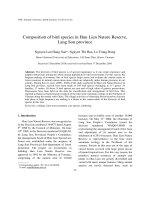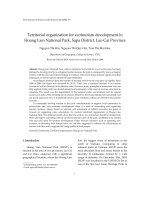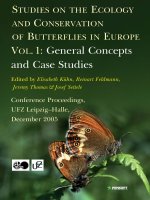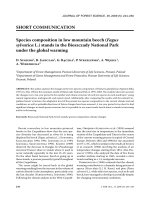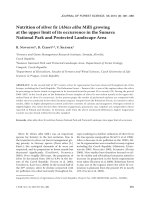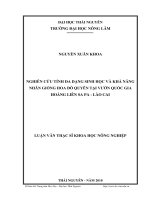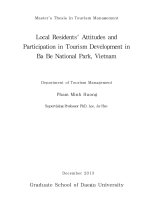Conservation of pinaceae in hoang lien national park lao cai province
Bạn đang xem bản rút gọn của tài liệu. Xem và tải ngay bản đầy đủ của tài liệu tại đây (1022.93 KB, 51 trang )
ACKNOWLEGDEMENT
First of all, I am grateful to teachers of Vietnam National University of Forest for
establishing me to complete this thesis. I would like to acknowledgement all members of
Hoang Lien National Park for support necessary things and provide me documents. I wish to
express my sincere gratitude to officers of my university for providing me with all the
necessary facilities. I take this opportunity to record our sincere thanks to all members of the
Falcuty of Forest Resource and Environment Management for their help and encouragement. I
am deeply indebted to my supervisor Assoc. Prof. Dr. Hoang Van Sam and Dr. Tobias
Matusch whose stimulating motivation and valuable ideas helped me to complete this thesis. I
also acknowledgement Sa Pa local government and local people for helping me during my
researching time in Sa Pa.
ABSTRACT
Plant of Pinaceae in Hoang Lien National Park is quite diversity with 5 species. All of
them listed in IUCN Red list 2015, which including Abies delavayi Franch.subsp.
fansipanensis (Q.P. Xiang & al.) Rushforth at CR- Critically Endangered level. There are 02
species in Vietnam Red Book 2007; 01 species listed in Decree 32/2006 / of Vietnamese
Government. The results of the research show that Pinaceae species distribute at elevations
between 1,000 m to less than 2500 m has Thong duoi ngua (Pinus massoniana D.Don),
Thong ba la (Pinus kesiya Royle ex Gord), Thong hai la(Pinus merkusii Jungh.& de Vriese).
And two species are distributed relatively narrow and at higher elevations (> 2500 m) as Van
sam (Abies devalayi ssp.fansipanesis Rushforth), Thiet sam (Tsuga dumosa (D. Don)
Eichler). Some solutions have been proposed to conserve and develop of Pinaceae species in
Hoang Lien National Park.
TABLE OF CONTENTS
ACKNOWLEGDEMENT
ABSTRACT
TABLE OF CONTENTS
APPENDIX
APPENDIX 1: TABLE
CHAPTER I. OVERVIEW OF THE RESEARCH ................................................................... 3
1.1. Worldwide research ............................................................................................................. 3
1.2. Research in Vietnam ............................................................................................................ 4
1.3. The study of Pinaceae in Hoang Lien National Park........................................................... 6
CHAPTER II. GOALS AND OBJECTIVES, CONTENT AND METHODS OF THE
RESEARCH ............................................................................................................................... 8
2.1. Research subjects. ................................................................................................................ 8
2.2. Objectives. ........................................................................................................................... 8
2.3. Contents. .............................................................................................................................. 8
2.4. Methods. .............................................................................................................................. 8
2.4.1. Field Investigation Method............................................................................................... 8
2.4.2. Non-Field Investigation Method .................................................................................... 11
CHAPTER III. NATURAL CONDITIONS – ECONOMY – SOCIAL OF RESEARCH
AREA ....................................................................................................................................... 13
3.1. Natural conditions of Hoang Lien National Park .............................................................. 13
CHAPTER IV. RESULTS AND ANALYSIS OF RESULTS ................................................ 21
4.1. Composition of Pinaceae investigation in Hoang Lien National Park .............................. 21
4.2. Determination of the distribution of the Pinaceae with altitude ........................................ 22
4.3. Morphological characteristics, distribution, ecology and natural regeneration capacity of
the species Thiet Sam and Van Sam in Hoang Lien National Park ......................................... 25
4.4. Proposed conservation measures Pinaceae in Hoang Lien National Park......................... 34
4.4.1. Technical solution .......................................................................................................... 35
4.4.2. Economic – social solutions ........................................................................................... 36
4.4.3. Solutions on mechanisms and policies to attract investment ......................................... 37
4.4.4. Strengthen enforcement .................................................................................................. 38
CONCLUSIONS ...................................................................................................................... 39
REFERENCES
APPENDIX
Figure 3.1. Hoang Lien National Park Map ............................................................................. 13
Figure 4.1. The distribution of the pines by height .................................................................. 23
Figure 4.2. Tsuga dumosa (D. Don) Eichler var. chinensis (Franch.) Pritz.) ........................... 25
Figure 4.3. Tsuga dumosa population in Hoang Lien National Park ....................................... 26
Figure 4.4.Tsuga dumosa’s fruit in Hoang Lien National Park ............................................... 29
Figure 4.5.Abies delavayi Franch.subsp.fansipanensis (Q.P. Xiang & al.) Rushforth in Hoang
Lien National Park .................................................................................................................... 29
Figure 4.6.Abies delavayi’s fruit in Hoang Lien National Park ............................................... 30
Figure 4.7.Abies delavayi population in Hoang Lien National Park........................................ 32
Figure 4.8. Abies delavayi composition forest in Hoang Lien National Park .......................... 33
Figure 4.9. Abies delavayi Franch.subsp.fansipanensis regeneration by seeds in Hoang Lien
National Park ............................................................................................................................ 34
PICTURES IN THE FIELD TRIP ........................................................................................... 41
APPENDIX 1: TABLE
Table 4.1. Composition of Pinaceae investigation in Hoang Lien National Park .................... 21
Table 4.2. Current status of Pinaceae’s conservation in the Hoang Lien National Park .......... 24
Table 4.3. Regeneration of Thiet sam and the other species ................................................... 27
Table 4.4. The regeneration of Van sam and other species accompanying.............................. 32
INTRODUCTION
Vietnam is one of the biodiversity centers of the world, in recent years biodiversity
resources are overexploited, so the issue of biodiversity conservation is an urgent requirement
in Vietnam today.
Hoang Lien National Park, Lao Cai province belongs to the National Park system in
Vietnam, was established under Decision No.90/2002 in 12thJuly 2002 of the Prime Minister
with a total area of 29,845ha. It is classified as A by Global Environment Fund, the most
senior of the biodiversity values of Vietnam and was recognized as ASEAN Heritage Park by
the organization Biodiversity Conservation of ASEAN. The National Park has many
differences compared to other national parks in the SUF system of Vietnam, due to the
exchange of the two sub-tropical climates temperate and alpine. The terrain, is rugged and
dissected, with steep slopes. Through the wonders created paint system formed on the 1,000m
high mountain peaks, including Fansipan peak which has the heightof 3.143mabove the sea
level, be considered as the "roof" of Indochina. With peculiarities of climate, weather, terrain
of Hoang Lien, was formed in this place fauna –the flora is extremely rich. Particularly where
flora of the forest is not only reflects the richness of the biodiversity of forest genetic
resources, but also determines the diversity of forests, scientific value, environmental value,
and landscape economic resources. Hoang Lien National Park is identified as one of the most
biodiversity centers in Vietnam by the scientists, where remnants of rare endemic species
listed in the Vietnam Red Book and World Red Book. Some studies show that, Hoang Lien
National Park is home to the main distribution of some species of plant in their views of
which two species Van sam (Abies devalayi ssp.fansipanesis Rushforth) and Thiet sam (Tsuga
dumosa (D. Don) Eichler) are among 17 endemic plant species rare-protection priorities.
According to the preliminary investigation in the Hoang Lien National Park,there is only one
population distribution focused on narrow stretches 2km eastern flank of Fansipan Mount
1
between 2,600 - 2,800 m, with an estimated population of 200-250 individuals and is at risk
due to habitat loss or other negative impacts. Specially, the issue of natural regeneration of the
two species Van sam and Thiet sam, Fansipan are poorly species degradation, reduce the
number of wild plant species, so conservation this issue is essential.
In recent years, in spite of the local authorities and communities have made efforts for
protecting the environment and biodiversity, forests and biodiversity in Hoang Lien National
Park has been destroyed and still has been deforested for firewood and agricultural
development. It is because of many reasons such as: lacking of effective solutions, forest
vegetation resources in general and Pinaceae in particular are still being heavily damaged.
Various cases of slash and burn cultivation are frequently reported, especially illegal
exploitation and trading of natural resources in large numbers still occur that seriously
decrease the number and habitats of these species. So studying Pinaceae conservation issues is
essential, not only in terms of scientific significance, but also has profound greatly practical
significance.
Stemming from the above situation, the implementation of the project "Conservation
of Pinaceae in Hoang Lien National Park, Lao Cai province" is necessary and urgent, in
accordance with the situation and conditions in local practices way, contribute to the
conservation of biodiversity resources of Lao Cai province in particular and across the nation.
2
CHAPTER I. OVERVIEW OF THE RESEARCH
1.1. Worldwide research
Botany in the world is very rich and diverse with approximately 250,000 species of
high plants, including Pinaceae accounted for 220-250 species.
Pinaceae are species most ancient origin, about 300 million years. The area of natural
famous Pinophyta forests are often referred to Europe with the species of spruce (Picea), Pine
(Pinus); North America with the conifers (Pinus), spare (Sequoia, Sequoiadendron) and Tsuga
dumosa (Pseudotsuga). The branches of Pinaceae has contributed significantly to the
economies of some countries such as Sweden, Norway, Finland, New Zealand … The long
history of China has recorded the origin of ancient tree branch Pinaceae still exist until today
and we can rely on it to guess their age.
Tree in the Pinaceae is one of the most important tree groups in the world. The large
Pinaceae forests in the Northern Hemisphere where clarify carbon dioxide and regulate world
condition. Many sierras in the world which include forest of Pinaceae’s species prevail on
playing important role to regulate water for the main river system. The terrible floods
hereabouts at lower areas such as China, India country is relating directly to over exploration
Pinaceae’s headwaters forest. There are a lot of species in botany, zoology and fungi depends
on Pinaceae to survive. Therefore, having no trees in Pinaceae, these species will be extinct.
Besides that, trees in the Pinaceae was provides wood for construction, plywood, farina and
paper products all around the world. Many other species was provided precious wood with
special uses such as building boat or art furniture. Mainly, trees in the Pinaceae has easily
outsourcing and be perdurable. In Chile, Fitzroya cupressoides is a species in Pinaceae of
temperature forest. The tree ups to 50m high and 3.600 years old. Stem of this tree was
founded in swamp where it was buried from 5000 years but the wood still has good use value.
There are over 80 Pinaceae species classified as branches which are threatened by
extinction in the world. Many other species are threatened in a natural distribution part of
3
species. The most common threat is the overexploitation of timber or other products,
deforestation for cattle grazing, farming and habitat for humans along with the increase in the
frequency of fires forest. The importance of Pinaceae branches to the world makes preserve
them become particularly significant. The complexity of the factors threatening encounter
requires a variety of strategies for conservation practices and sustainable use of these species.
In-situ conservation by using mechanisms such as establishing the national park and nature
reserve is a good solution, effective for large areas of primary forest remaining. Conservation
requires the cooperation of people from all professions and different organizations. The
people who do this work depended on the accurate identification target species or other
organisms relevant and updated information on the extent of local, regional, national and
international.
1.2. Research in Vietnam
Currently, there are about 12 species of Pinaceae in Vietnam. Although is lower than
5% of species known in all over the world was found in Vietnam but Pinaceae species which
have listed in Vietnam Red Book accounted for about 45%, this is not a small number.
Table 1.1. Pinaceae species in Vietnam
No.
Vietnamese name
Scientific name
1
Vân sam Fansipan
Abies delavayi fansipanensis
2
Thiết sam
Tsuga dumosa
3
Thông hai lá
Pinus merkusii
4
Hinh đá vôi
Keteleeria calcarea
5
Du sam đá vôi
Keteleeria davidiana
6
Thông Caribe
Pinus caribaea
7
Thông Đà Lạt
Pinus dalatensis
8
Thông ba lá
Pinus kesiya
9
Thơng đi ngựa
Pinus massoniana
10
Thơng Pà Cị
Pinus kwangtungensis
11
Thơng Xn Nha
Pinus cernua
12
Thông lá dẹt
Pinus krempfii
4
All species belong to Pinaceae in Vietnam are significant. Two species Thiet sam and
Van sam are endemic species in Vietnam. Evenly, the species are not endemic species of
Vietnam, they also have great significance. For example, Pinus kesiya Royle ex Gord (Pinus
kesiya) we can see them from Northeast India to Philippine. However; in Vietnam, it has
highest productivity through assay in Africa and Australia. These are the facts shows that the
significance of species belongs to Pinaceae of Vietnam to the World.
Most of all natural Pinaceae species of Vietnam are under threat in certain levels. Most
precious wood species are suitable for use as handicrafts or to build, while other species have
value as flavoring quarter or be used as medicines both in traditional medicine or modern
medicine. Some species are only used in local but these are species with restricted
distribution. Threatened by direct exploitation was accompanied by the changing of large
forest areas into agricultural land, especially in the mountains with an elevation of 800 to
1,500 meters where the plants in the Pinaceae usually live. The split forests discretely is a
related issue. The remaining group of small forest is easy to be fired and vulnerable due to
decline genetic, the species which have small wild populations are particularly susceptible to
these threats. These species are widely distributed populations, in some cases, distributed both
in other countries, may create the impression that less threatened species than the reality
because of overexploitation and deforestation are the problems of all the countries in
Southeast Asia.
Many Pinaceae species have economic value and the science have been studied to
serve conservation and reforestation. In the 12 known species Pinaceae in Vietnam has more
than a half of the tested species propagated by cuttings.
There are many researches on Pinaceae species in Vietnam:
Ministry flora Indochina by H. Lecomte editor (1907-1952) the French author has
collected samples and the name, set course description vascular plant species throughout the
5
territory in which the species Indochinese Conifer branches was introduced and described
quite clearly here.
Based on the flora of Indochina, recent flora of Cambodia, Laos and Vietnam by
Aubréville initiator and editor (1960-1997) along with many other authors have published a
lot of species of vascular plants . In which Pinaceae species were introduced.
We have to mentionis that Vietnam Herb of Pham Hoang Bo (1991-1993)
published in Canada and has been reprinted with supplementation in Vietnam for 2 years
(1999-2000) and it is the most noticeable book. This is a fairly complete set of easy to use and
significantly contribute to the plant science of Vietnam Conifer.
Most recently the book: Pinophyta Vietnam's Nguyen Nghia Thin (2004), or book
Communication Vietnam study conservation status in 2004 Nguyen Tien Hiep and
colleagues. This is the book study, a clear description of some conifers, as well as providing
the status and conservation of certain species of Vietnam Conifer branches.
Besides scientific researches in order to conserve the species at risk are
threatened, there is a range of policies related to conservation has also been announced by the
State through the Ministry of Law, Decree, Decision ... as Law forest protection and
development, systems management strategy nature reserve Vietnam and Decree No. 32/2006
/Decree - Government of March 30 2006 on the management of forest flora and fauna
endangered, rare and precious. In this Decree was announced the list of species of animals and
plants prohibited forest exploitation, use for commercial purposes, including the species:
Abies delavayi, Pinus kwangtungensis. The group which is limited exploitation or used for
commercial purposes which is the species Pinus dalatensis, Keteleeria evelyniana Mast .
1.3. The study of Pinaceae in Hoang Lien National Park
Studies of Pinaceae in Hoang Lien National Park must be mentioned are:
Vo Van Chi (1970), vegetation and flora in Fan Si Pan and Sapa.
6
Nguyen Nghia Thin, Daniel Harder (1996), Diversity of the Flora of Fansipan, the
highest mountain in Vietnam.
Nguyen Nghia Thin Nguyen Thi Thoi (1998), diversity of vascular plant species in Sa
Pa mountainous - Fan Si Pan.
Andrrew T, Steven Sw, Mark G and Hanna S (1999),Hoang Lien Natural Reserve,
Investigating biodiversity and conservation values.
Nguyen Quoc Tri (2007), diversity of plant and plant transformation by elevation in
Hoang Lien National Park, Lao Cai Province.
7
CHAPTER II. GOALS AND OBJECTIVES, CONTENT AND METHODS
OF THE RESEARCH
2.1. Research subjects.
The plant species of Pinaceae in Hoang Lien National Park, Lao Cai Province.
2.2. Objectives.
Assess the diversity and conservation status of some species of Pinaceae in Hoang
Lien National Park, Lao Cai Province; then propose solutions to preserve and develop
Pinaceae in research area.
2.3. Contents.
- Assessment of diversity and distribution of Pinaceae species in the area of Hoang
Lien National Park, Lao Cai Province.
- Research the characteristics of biology, ecology of some important species in
Pinaceae in Hoang Lien National Park.
- Propose conservation measures and develop Pinaceae in Hoang LienNational Park.
2.4. Methods.
2.4.1. Field Investigation Method
2.4.1.1. Transect line method
The transect linear used to illustrate a particular gradient or linear pattern along the
communities of Pinaceae species. They provide a good way of being able to clearly visualize
the changes taking place along the line. The transect line have design in the map depend on
the discussion with local experts and rangers of Hoang Lien National Park.
Using GPS to determine the distribution of species in transect line in the map of flora
of Hoang Lien National Park.
8
2.4.1.2. Field investigation
Investigate the distribution and density of Pinaceae species.
Using GPS to determine high density areas, high biodiversity areas, and areas of good
conditions.
Investigate harmful factors which destroy environment, ecosystem and habitat of
Pinaceae plants.
2.4.1.3.Data collection
2.4.1.3.1. Investigation of high individual species
This method use to evaluate the status of species and investigate the factors affected
those species.
Setting up sample plots to study some physiological characteristics of the species ( 12
plots with area of 600m2 and 10 transect lines)
Investigate and measure individual species in selecting areas to find out growth rate.
Investigate, collect specimens, and calculate all of the individuals species found in
diameter at breast height (D1.3) greater than or equal to 6cm.
D1.3 measured by calipers glasses
Measuring tree height (HVN) and the high under branch (Hdc) by
Blummleiss
measure.
Measuring canopy diameter (Dt) by tape in two dimensions East - West and South.
For the trees difficult to measure (due to difficult terrain) using empirical observation
position from the tree was measured.
9
Table1 : Investigation of species in transect line
Transect line...
Forest type...
Coordinates of transect line...
Days of investigation :
No
Areas
Species
Researchers :
D1.3(cm)
Hvn(m)
Dt(m)
Height
Status
Note
1
2.4.1.3.2. Investigation of reproduction species
Investigation of natural reproduction species along the transect line. Observe the status
of those species, specially the species near parent trees.
Table 2 : Investigation of reproduction trees in transect line
Transect line...
Forest type...
Coordinates of transect line...
Days of investigation:
No
Species
Researchers:
Source
Height of trees ( cm )
<50
50-100
of
reproduction
>100
Seeds
Buds
Growth rate
A
Note :
A: Good
B: Normal
C: Bad
Investigation of natural reproduction species near parent trees.
10
B
C
Set up the sample plots with the size of 4m2 (2m x 2m) around the parent trees by four
directions, 4 plots in canopy, 4 plots out of canopy.
Determine the density of reproduction trees : Density (N) is calculated using the
formula:
N = (N / S) × 10000 (trees / ha)
We have :
N: the number of counted trees in the area of S (tree)
S: measurement area (m2)
2.4.1.3.3. Determination of the distribution by elevation.
Using GPS to determine the distribution by elevation of each individual species. Based
on the results of the investigation of the distribution of species and topographic maps were
digitized under different elevation to divide by the appropriate elevation and precise.
2.4.1.3.4. Identifying competitive species.
Using the formula of Hegyi (1974) applied to calculate the competitiveness index of
central plant :
We have:
Cj is a competitiveness index of tree species j for the center, the greater
Cj complete means that greater compete with central plant.
Dj is the diameter at breast height of competition plant j
Dj is the diameter at breast height of central plant
Lij is the distance from central plant to competition plant j
Cell radius = diameter of the largest canopy of central plant
2.4.2. Non-Field Investigation Method
2.4.2.1. Interview
Interview 30 local people and 30 local officials to get information about what people
affect to forest plant and forest product. This method is used to assess about the awareness of
11
local community and tourist about Pinaceae species. Interview is the best survey method,
because this method can get information from large number of people in community about a
specific subject in a short period of time.
2.4.2.2.Data processing and analysis
- Using computer to summary data, using excel make table and do the presentation.
- Make a list of plant in Hoang Lien National Park.
Calculate the average value of the species: D1.3 (cm), Hvn (m), Hdc (m), Dt (m).
Using formula to determine species reserve: Vi = Gi x Hivn xf
Where:
V: tree reserve number i
Gi: cross section of tree number i at 1,3m.
Hivn : the tree height of tree number i
f: the narrow index (f = 0.45)
Using a paired comparison method to assess results
12
CHAPTER III. NATURAL CONDITIONS – ECONOMY – SOCIAL
OF RESEARCH AREA
3.1. Natural conditions of Hoang Lien National Park
3.1.1. Geographic location.
Hoang Lien National Park is located to the northwest of Sa Pa district in the area of
Northwest of Vietnam, which have geographical coordinates:
From 22o00’to 22o23’north latitude;
From 103o00’ to 104o00’ east longitude.
Figure 3.1. Hoang Lien National Park Map
13
Regarding its administrative boundaries located in 6 communes: San Sa Ho, Lao Chai,
Ta Van, Ban Ho (Sa Pa district) and part of the Muong Khoa, Than Thuoc (Than Uyen
District, Lao Cai Province), with boundaries adjacent to the world:
+ Bound in the eastern borders: Thanh Kim, Nam Sai, Nam Giang district and Ta Phoi
commune (Sa Pa District, Lao Cai Province);
+ Bound in the west: Ban Bo, Binh Lu (Tam Duong District, Lai Chau Province);
+ Bound in the south and southeast: Nam Xe Commune (Van Ban District, Lao Cai
province) and 04 commune: Phuc Khoa, Than Thuoc, Ho Mit, Tan Uyen town (Tan Uyen
district, Lai Chau province);
+ Bound in the north: Ta Giang Phinh, Trung Chai, Ta Phin, Ban Khoang (Sa Pa
District, Lao Cai Province).
- The Management Board of Hoang Lien National Park’s head office is located in the
town of Sa Pa, far away about 36km from Lao Cai and 350km away from Hanoi. The total
area of land under the management of Hoang Lien National Park is 51 800 ha, which 29 845
ha is core zone. The core area of the National Park boundaries belongs to the northeast flank
while the buffer zone (Than Uyen district) is located in northwest flank.
3.1.2. Topography
Hoang Lien National Park is located in an area which is diverse and complex,
including mainly alpine and high average, runs continuously from the Northwest to the
Southeast, through the border from China to Van Yen ( Yen Bai), with the width reach to
30km. Hoang Lien National Park has many peaks over 2000m, which has the highest peaks is
Fansipan (3.143m) and is considered the roof of Indochina. Speed raised during the Cenozoic
hard, together with the process of erosion, denudation occur in hardened lava (Mama acid)
made for the mountain terrain character, very sharp watershed. Average slope is relatively
large from 25 to 35 degrees, in the high mountain slopes sometimes longer slope reaches 40 –
14
45o. The deep divide very intense, the difference between the peaks and valleys (the high
relatively) is quite large, some places depth to 1000 - 1500m. However, due to the fast pace
increased, while slow, quiet ... as well as the formation of ancient leveled surface, as the
surface of 2100 - 2200m, 1700 - 1800m, 1350 - 1450m ...
In addition to the height of the mountains, the region is still expanding valleys with
fertile land accretion as Muong Hoa valley of Ta Van, Lao Chai (Sapa) and Than Thuoc
(Than Uyen).
Generally the terrain park divided worms and strong, high mountains, steep slopes
with the terrain type is as follows:
+ Alpine terrain type (N1)
+ Average mountain terrain type (N2)
+ Low mountain topography (N3)
+ Valley topography (T1) and trough valleys (T2)
3.1.3. Geology and soil
The origin of the Hoang Lien regional geology that formed from the Triassic and
influenced many of the activities created Indexin paint, small geological age Hoang Lien
Mountains including Fansipan peak is considered young mountains, sharp peaks due to the
natural geologic erosion was not long.
Rocks in the region are 2 main groups: acid magma stone and metamorphic rocks with
the main categories such as: Granit, gnai, amphibolite, Filit, limestone, and shale somewhat
clay, sandstone, shale, which granite is the most popular.
Soils: The National Park has the following types of land:
+ Humus Alit alpine N1> 1700m:
+ Feralit humus land in average mountain N2 (700 - 1700m)
+ Feralit red gold land in low mountains N3 (500 - 700m)
15
+ Soil sediment accretion streams
3.1.4. Climate and hydrological
3.1.4.1 Climate elements
Hoang Lien National Park is located adjacent to the Tropic of Cancer in northern
hemisphere Asian tropical belt, which has climate with two seasons with the typical cold. Wet
summer starting in May until the end of October and led to heavy rains, often cause flooding,
particularly flash floods, landslides; winter from early November to the end of April next
year, the coldest is December and January, the month usually appear frost, which can last
from 3 to 10 days.
The basic characteristic of the climate of Hoang Lien National Park are as follows:
- Heat Mode: The annual average temperature is 15,4oC, in the summer months the
average temperature between 18 ÷ 20o C, in the winter months from 10 ÷ 12oC. High
temperature 33oC (in April, in the lowlands); the average low temperature is 12,6oC, the
absolute minimum temperature of between 1 to 20oC (especially the years down to - 3,2oC).
Low temperatures are from December to February the following year, on the higher peaks
after the temperature drops below 0oC and snowy. Total temperature is during the year from
7,500 ÷ 7.800oC.
- Precipitation, humidity: The average annual rainfall is 2.759mm, maximum is 3,484
mm and unevenly distributed over the month; the average number of rainy days in 199.4 days
and irregular movements among seasons.
- Mode of sunshine: Total annual average sunshine hours of the area Hoang Lien
National Park ranged 1.400 ÷ 1,460 hours. Uneven number of days between the months of
sunshine, summer many hours of sunshine, sunshine annually least in April from 180 ÷ 200
hours, October is the month the sun at least between 30 ÷ 40 hours. The amount of average
annual evaporation is 865,5mm.
16
- Wind regime: Area of Hoang Lien National Park has two main wind directions and
are distributed according to the season, summer west and northwest winds, winter north and
northeast winds, the average wind speed of about 1,1m / s.
- Fog, frost: Fog often appears common throughout the year, especially in winter
where there is some degree of very thick. On average there are about 160 days in fog; in an
average year, about 6 days with ice, but sometimes prolonged period of 3 to 5 days, to 11 days
maximum.
- Snow, sleet: frequency of occurrence from 4 ÷ sleet 6 years / times, the freezing days
of winter, the temperature down on the peak> 2,500m usually have snow, sometimes snow
down to 1500m altitude covered the town of Sa Pa.
3.1.5. Forest resources
3.1.5.1. Forest vegetation
The study results showed that the vegetation in Hoang Lien National Park is a fairly
typical full differentiation by elevation of the territory. Due to the special nature of the terrain
and climate, the vegetation here is diverse and brings many distinct positions. However today
this vegetation has been extremely profound change compared to its native state. Today the
state of primary forest or less affected exist only on the high ridges rugged, mainly at
elevations above 2.400m or separate clouds with scattered small area in the region.
3.1.5.2. Current status of forest and land use
The total area of the Hoang Lien National Park is 28 509 hectares, of which:
- The area of forest is: 23287.92 hectares, equivalent to 81.68% coverage is
- Natural forest area are: 22819.47 hectares, reaching 80% of total natural area (rich
forests undisturbed 687.87 hectares of forest and forest Average 5501.72 hectares have been
hit hard poor 4772, 81 ha of forest restoration 11374.45 ha). The distribution of this type of
17
forest, interwoven in the area of the park, forming many different plant communities are
favorable habitat and source of food for many species of wild animals.
- Planted forest area of 468.59 ha (accounting for 1.65% of the natural area), the
Hoang Lien National Park plantation crops including vegetable group, indigenous and rare
(Sa moc, Voi Thuoc, ....), is grown for the purpose of conserving the genetic resources of rare,
restored on bare land, old upland fields, forest land not belonging to the communes of Ta Van,
Ban Lake and San Sa Ho.
- The area of land is 3969.49 hectares of forest without accounting for 13.9% of total
natural land area of the park, including vacant land I C status (1.625,26ha) and vacant land status (I
A and I B) are 2344.23 ha. Including land regenerated tree, shrub land, grassland, forest land
without team but serve as feeding grounds of herbivorous mammals, ungulates groups.
3.1.6. General assessment of natural conditions
Hoang Lien National Park covers larger areas than other national parks in the North of
our country. Hoang Lien national park is not only famous in Vietnam but also in other
countries for its spectacular scenery. The process of creating the painting was forming steep
cliffs towering of spikes, on which is the unique flora such as: dwarf forest with bizarre
shapes, ancient moss, Do quyen (Rhododendron)monoculture forest, Truc lun (Pseudosasa
humilis) pure dwarf forest, ... that is the characteristic landscape cannot find in the other
special-use forests in Vietnam.
Due to the diverse natural conditions gave the Hoang Lien National Park rich diversity
of animal and plant species composition. The composition of the park plants make up 23% of
plant species composition has been discovered in the country, components account for 30% of
mammals, amphibians also up 60%.
With forest area reached 82% coverage, Hoang Lien National Park is not only the
important role of natural ecological environment in Vietnam but also in Southeast Asia.
18
Hoang Lien National Park forest area also watershed protection values two critical river
systems flowing through the provinces of Lai Chau, Lao Cai, Yen Bai. They play an
important role in the regulation of irrigation water for agricultural production activities of the
communes, districts and provinces downstream.
Despite the passage of time, Hoang Lien National Park has made great efforts in the
conservation of biodiversity values and natural landscapes, but the park's natural values are in
decline because of human impact and natural disasters, soil coating strongly affected by local
topography is steep, rain water, vulnerable to heavy erosion, if the class is destroyed
vegetation will lead to land depression. To preserve and promote these values, demands a
comprehensive management plan and scientists with the participation and support of many
agencies and departments from the central to local levels and special people in the region.
3.2. Economic conditions - social research area
Hoang Lien National Park is home to 08 ethnic groups, including ethnic Hmong
approximately 37.6% (the majority living in the communes in Sa Pa district), Thais accounted
for 36.4 % (concentrated mainly in Tan Uyen district), accounting for 6.5% of Dao, the rest
are ethnic groups such as Tay, Giay, Khmu, Lao, Kinh.
As of May 4/2014 the population in the province of Hoang Lien National Park is 25
229 people of 4638 households living in 39 villages in six communes in Hoang Lien National
Park. Of which 375 households located deep in the core area of the 5 villages Ma Quai Ho,
Seo Trung Ho, Ta Trung Ho, Den Thang, Seo My Ty and 14 communes adjacent national
park boundaries; equilibrium 5-6 per person / household.
Culture: communities who living in Hoang Lien National Park consists of many
different ethnic groups, so the cultural activities are also very diverse with specific
characteristics. However, due to difficult traffic conditions, economy is poor, the mass media
19
